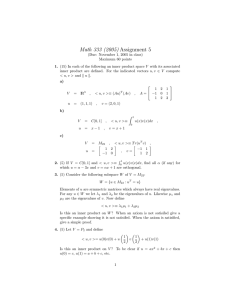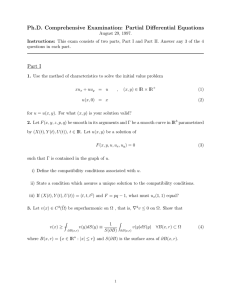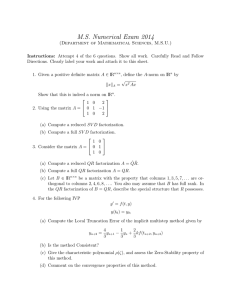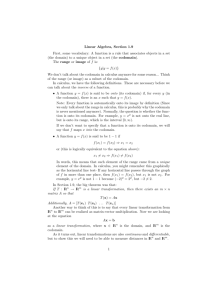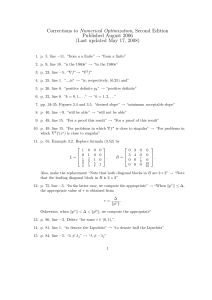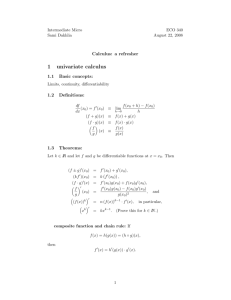Math 333 Linear Algebra Supplementary Lecture Notes Contents Mark Pernarowski
advertisement
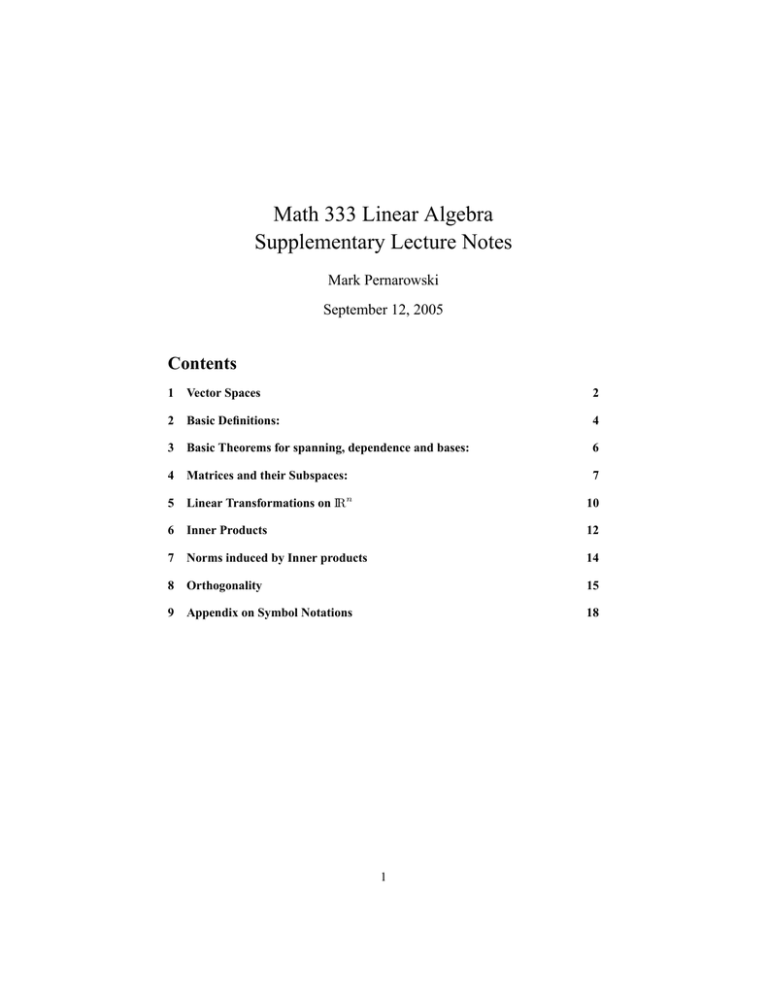
Math 333 Linear Algebra
Supplementary Lecture Notes
Mark Pernarowski
September 12, 2005
Contents
1
Vector Spaces
2
2
Basic Definitions:
4
3
Basic Theorems for spanning, dependence and bases:
6
4
Matrices and their Subspaces:
7
5
Linear Transformations on IRn
10
6
Inner Products
12
7
Norms induced by Inner products
14
8
Orthogonality
15
9
Appendix on Symbol Notations
18
1
1 Vector Spaces
Definition 1 Let V be a nonempty set on which the operations of addition + and scalar
multiplication have been defined:
(i)
(ii)
u+v
cu
is defined ∀u, v ∈ V
is defined ∀u ∈ V, ∀c ∈ IR .
The set V is called a vector space if additionally, ∀u, v, w ∈ V and ∀b, c ∈ IR the
following axioms hold:
(A1)
(A2)
(A3)
(A4)
(A5)
(A6)
(A7)
(A8)
(A9)
(A10)
u+v ∈V
u+v =v+u
u + (v + w) = (u + v) + w
∃0 ∈ V such that u + 0 = u
∃ − u ∈ V such that u + (−u) = 0
cu ∈ V
c(u + v) = cu + cv
(b + c)u = bu + cu
c(βu) = (cβ)u
1u = u
V closed under addition
addition is commutative
addition is associative
existence of a zero vector
existence of a negative element
closed under scalar multiplication
distributive property I
distributive property II
commutativity of scalar multiplication
scalar multiplication identity element
Sometimes the symbols ⊕ and ¯ will be used to denote vector addition and scalar
multiplication, respectively. This will be done when vector addition and scalar multiplication is defined in a nontraditional way such as in the example below. Then u + v
will be written u ⊕ v and cu will be written c ¯ u.
Example 1 : Let
V = {u : u = (u1 , u2 ) ∈ IR2 }
and
u⊕v
c¯u
≡
≡
(u1 + v1 + 1, u2 + v2 + 1)
cu = (cu1 , cu2 )
It is easy to show axioms (A1)-(A3) are satisfied. For instance
u ⊕ (v ⊕ w) = (u ⊕ v) ⊕ w = (u1 + v1 + w1 + 2, u2 + v2 + w2 + 2)
At first glance it might seem (A4) is not satisfied. However, if one defines 0 = (−1, −1),
we have 0 ⊕ u = u for all u including u = 0. For this definition of 0 assumption (A5)
is then satisfied if one defines
−u ≡ (−u1 − 2, −u2 − 2)
since then
u ⊕ (−u) = (−1, −1)
,
∀u .
Assumption (A6) is trivially satisified and it is easy to verify (A9)-(A10) are as well.
However, (A7) is not satisfied since
c(u ⊕ v)
cu ⊕ cv
=
(cu1 + cv1 + c, cu2 + cv2 + c)
=
(cu1 + cv1 + 1, cu2 + cv2 + 1)
2
implies c(u ⊕ v) 6= cu ⊕ cv for all c. They are equal for c = 1 but not for all c.
Similarly, (A8) is not satisfied since
(b + c)u = (bu1 + cu1 , bu2 + cu2 )
bu ⊕ cu = (bu1 + cu1 + 1, bu2 + cu2 + 1)
So in summary, all but axioms (A7) and (A8) are satisfied and one concludes that V
is not a vector space. Of course with the usual (Euclidean) definitions of addition and
scalar multiplication IR2 is a vector space.
Example 2 Let V be the set of (possibly empty) sets of real numbers. Thus, an “element” of V is a set of real numbers. Then we define vector addition to be set union:
u⊕v ≡u∪v
For example, if u = {1, 2, 3} and v = {3, 4} we have u ⊕ v = {1, 2, 3, 4}. Next we
define scalar multiplication as the identity operation. That is, for any real number c
and vector u ∈ V
c¯u≡u.
Then (A1) is satisified. With the stated definitions the question one must ask is if a
union of two sets of real numbers u and v is a set of real numbers. Clearly it is so
(A1) is satisfied. Furthermore, set union is commutative so (A2) and (A3) are also
satisfied. Oddly enough, (A4) is satisfied if one identifies the zero vector 0 as the empty
set, i.e., 0 = { }. Because of how scalar multiplication was defined (A6)-(A10) are
also all satisfied. The only axiom which fails is (A5). There is no set “−u” which when
unioned with u yields the empty set 0. Note that in this case, “real numbers” could
have been replaced with anything, i.e. bank accounts, gliorps, cats...
Some Common Vector spaces:
IRn
Mmn = IRm×n
Pn
C(IR)
C n (IR)
C ∞ (IR)
F (IR)
the set of all ordered n-tuples of real numbers
the set of all real m by n matrices
the set of all n-th degree polynomials
the set of all continuous functions on IR
the set of all functions on IR with n continous derivatives
the set of all functions on IR with continuous derivatives of all orders
the set of all function defined on IR
Note that the function spaces are subsets:
Pn ⊂ C(IR) ⊂ C 1 (IR) ⊂ C 2 (IR) ⊂ · · · C ∞ (IR) ⊂ F (IR)
3
2 Basic Definitions:
In all of the following V is a vector space:
Definition 2 W is a subspace of V if
a)
b)
c)
W ⊂V
u, v ∈ W ⇒ u + v ∈ W
u ∈ W, c ∈ IR ⇒ cu ∈ W
(subset)
(closure under addition)
(closure under scalar addition)
This theorem implies W is also a vector space (see text).
Definition 3 w ∈ V is a linear combination of v1 , . . . vn ∈ V if ∃ck ∈ IR such that
w = c 1 v1 + c 2 v2 + · · · c n vn
Definition 4 Let S = {v1 , v2 , . . . vn } ⊂ V .
(
n
X
c k vk
span(S) ≡ w ∈ V : w =
k=1
f or some ck ∈ IR
)
In words, W = span(S) is the set of all linear combinations of the vectors v1 , v2 , . . . vn .
Note that W is a subspace of V .
Definition 5 A set S = {v1 , v2 , . . . vn } ⊂ V is linearly independent if
c 1 v1 + c 2 v2 + · · · c n vn = 0
⇒
ck = 0
,
∀k = 1, . . . n.
If S is not linearly independent S is said to be linearly dependent.
If S is (linearly) dependent then at least one vector v ∈ S is a linear combination of
the remaining vectors.
Definition 6 A set E = {e1 , e2 , . . . en } ⊂ V is basis for V if
a)
b)
E is linearly independent
V = span(E)
By a theorem, if E = {e1 , e2 , . . . en } is a basis for V then for every v ∈ V there
are unique scalars c1 , . . . cn such that
v = c 1 e1 + · · · c n en
Moreover, if
w = b 1 e1 + · · · b n en
then
v 6= w ⇔ (c1 , . . . , cn ) 6= (b1 , . . . , bn )
This permitts the following definition.
4
Definition 7 The coordinate (v)E of v ∈ V relative to the basis E = {e1 , e2 , . . . en }
is that unique c = (c1 , . . . cn ) ∈ IRn such that v = c1 e1 + · · · cn en , i.e.,
c = (v)E
⇒
v = c 1 e1 + · · · c n en
Definition 8 If E = {e1 , e2 , . . . en } is a basis for V and 1 ≤ n < ∞ then V is said
to be finite dimensional with dimension
dim(V ) = n
If V = {0} then dim(V ) = 0.
5
3 Basic Theorems for spanning, dependence and bases:
Theorem 1 Let V be a vector space with dim(V ) = n < ∞, having basis
E = {e1 , . . . en },
W be any subspace of V and let
S = {v1 , . . . vk } ⊂ V
be a finite collection of k vectors. Further define the set of coordinate vectors:
SE = {(v1 )E , . . . (vk )E } ⊂ IRn .
Then,
S dependent
⇔
∃v ∈ S such that v ∈ span(S − {v}).
k>n
⇒
S dependent
k<n
⇒
S does not span V
v∈
/ span(S) and S independent
⇒
S + ≡ S ∪ {v} independent
v ∈ span(S − ) ≡ span(S − {v})
⇒
span(S) = span(S − )
V = span(S)
⇒
∃S − ⊂ S , S − a basis for V
V = span(S) and k = n
⇒
S a basis for V
S independent and k = n
⇒
S a basis for V
dim(W ) = dim(V )
⇒
V =W
S independent in V
⇔
SE independent in IRn
V = span(S) and k = n
⇔
IRn = span(SE )
dim(W ) ≤ dim(V )
6
4 Matrices and their Subspaces:
In the following A, B ∈ IRm×n are matrices, x ∈ IRn and y, b ∈ IRm . We shall
define ri to be the row vectors of A and cj to be the column vectors so that
.
..
.. ..
..
· · · · · · r1 · · · · · ·
.
.
.
· · · · · · r2 · · · · · ·
..
=
A = [aij ] =
· · · · · · · · · · · · · · · c1 c2 . c n
..
..
.. ..
· · · · · · rm · · · · · ·
.
.
. .
For any matrix, its transpose AT is defined by
AT = [aji ]
Important properties of the transpose are
(A + B)T
= AT + B T
(AB)T
= B T AT
For square matrices A, B ∈ IRn×n having inverses A−1 and B −1 , respectively,
(AB)−1
(A−1 )T
=
=
B −1 A−1
(AT )−1
A simple proof of the latter can be seen from the calculations:
xT
= A−1 b
= bT (A−1 )T
xT
I
= xT AT (A−1 )T ,
= AT (A−1 )T .
x
∀x
Also, for any matrix one can define the four fundamental subspaces:
Definition 9 The four fundamantal subspaces of A are
row(A)
≡
span{r1 , r2 , . . . rm } ⊂ IRn
col(A)
≡
span{c1 , c2 , . . . cm } ⊂ IRm
N (A)
≡
{x : Ax = 0} ⊂ IRn
N (AT )
≡
{y : AT y = 0} ⊂ IRm
Note that row(AT ) and col(AT ) have not been included since for every A ∈ IRm×n ,
col(A) = row(AT ) .
Bases for row(A), col(A) and N (A) can all be found by row reducing A to its upper
echelon form U .
7
Definition 10 Two matrices A, B ∈ IRm×n are said to be row equivalent if a finite
number of row operations (addition, multiplication and permutation) convert A to B.
When such matrices are row equivalent we write
A∼B.
Theorem 2
A∼B
A∼B
⇒
⇒
row(A) = row(B)
N (A) = N (B)
Row operations do not preserve the column space. For instance
·
¸
·
¸
1 0
0 0
A=
∼B=
0 0
1 0
by a simple permutation of rows but clearly col(A) 6= col(B).
Definition 11 Let A ∈ IRm×n and b ∈ IRm . A system Ax = b is consistent if it has
a solution.
Theorem 3 (General Solutions) Let A ∈ IRm×n and b ∈ IRm ,
Ax0
=
b.
Then,
Ax = b
⇒
∃v ∈ N (A) such that x = x0 + v .
Here x0 is called a particular solution and v is the homogeneous solution. Written
another way, if x0 is “a” solution and x is any other solution then there exists constants
c1 , . . . ck such that
x = x 0 c 1 v1 + · · · c k vk
where
E = {v1 , . . . vk }
is a basis for N (A). Also, conversely, if Ax0 = b, v ∈ N (A) and x = x0 + v then
Ax = b.
Next we describe one method for finding bases for row(A), N (A) and col(A). Suppose that after row reduction one reduces A to U having the form:
. . . u1 . . .
1 ∗ ∗ ∗ ∗ ∗
0 0 1 ∗ ∗ ∗ . . . u2 . . .
A∼U =
0 0 0 1 ∗ ∗ = . . . u3 . . .
0 0 0 0 0 1 . . . u4 . . .
... 0
...
0 0 0 0 0 0
In this example, there are 4 pivots (leading ones in rows). A basis E(row(A)) for
row(A) is the four non-zero row vectors of U , i.e.,
E(row(A)) = {u1 , u2 , u3 , u4 }
8
from which we know dim(row(A)) = 4. Also, the 4 pivots in U occur in columns
1,3,4 and 6. A basis E(col(A)) for col(A) is the 1rst , 3rd , 4rth and 6th columns of A,
i.e.,
E(col(A)) = {c1 , c3 , c4 , c6 }
The columns of U which contain no pivots correspond to free variables. There are 2
free variables x2 and x5 since columns 2 and 5 contain no pivots. This means that by
backsolving U x = 0, the remaining variables can be written in terms of x2 and x5 .
This procedure implies that any solution of U x = 0 can be written in the form
x = x 1 v1 + x 2 v2
where the vectors v1 , v2 form a basis E(N (A)) for N (A), i.e.,
E(N (A)) = {v1 , v2 }
A basis for N (AT ) is found by row reducing AT and applying a similar procedure.
Note that an alternate method for finding a basis for col(A) uses the fact that col(A) =
row(AT ). Thus, by finding a basis for row(AT ) thru row reduction of AT , one is
actually finding a basis for col(A).
Knowing these methods for finding bases we have the following definitions and Theorem.
Definition 12
rank(A)
nullity(A)
≡
≡
dim(row(A))
dim(N (A))
Theorem 4 Let r = rank(A) and A ∈ IRm×n .
dim(row(A))
dim(col(A))
dim(N (A))
dim(N (AT ))
9
= r
= r
= n−r
= m−r
5 Linear Transformations on IRn
Definition 13 A linear transformation T on IRn is a function T : IRn → IRm such
that
T (x) = Ax
for some matrix A ∈ IRm×n . The matrix A is called the standard matrix associated
with T which we notationally denote
[T ] = A
so that T (x) = [T ]x.
This definition implies certain algebraic properties about linear transformations on IR n :
Theorem 5 T : IRn → IRm is a linear transformation if and only if
(a) T (x + y) = T (x) + T (y) , ∀x, y ∈ IRn
(b) T (kx) = kT (x) , ∀x ∈ IRn , ∀k ∈ IR
(1)
(2)
This equivalence mean that properties a)-b) of the Theorem could be used to define linear transformations on IRn . Later, this will be the definition for linear transformations
on abstract vector spaces V .
Definition 14 Let f be a function from X into Y , i.e., f : X → Y . The domain D(f )
of f is defined by:
D(f ) = {x ∈ X : f (x) is def ined}
The range R(f ) of f is defined by:
R(f ) = {y ∈ Y : y = f (x) f or some x ∈ X}
In this setting Y is called the codomain of f . Also, if y = f (x) for some x ∈ D(f ),
then y is the image of x under f .
Note that if T is a linear transformation on IRn , D(T ) = IRn . In general, however,
R(T ) ⊂ IRm .
Definition 15 The function f : X → Y is 1 − 1 on D(f ) if
∀x1 , x2 ∈ D(f ),
,
f (x1 ) = f (x2 )
⇒ x1 = x 2
Definition 16 If f : X → Y is 1-1 on D(f ) then f has an inverse f −1 : Y → X
where D(f −1 ) = R(f ) and
f −1 (f (x)) = f (f −1 (x)) = x,
,
∀x ∈ D(f )
For linear transformations T on IRn that are 1-1, the inverse of T is denoted T −1 and
[T −1 ] = [T ]−1 .
10
Theorem 6 Let T : IRn → IRn and T (x) = [T ]x = Ax. Then, the following are
equivalent:
a) T is 1-1
b) A is invertible
c) N (A) = {0}
d) Ax = b is consistent ∀b ∈ IRn .
e) det(A) 6= 0
f) R(T ) = col(A) = row(A) = IRn
g) rank(A) = n
h) nullity(A) = 0
If the standard basis vectors for IRn are e1 , . . . en then we have the following useful
Theorem for determining the standard matrix [T ] of a linear transformation T :
Theorem 7 Let T : IRn → IRm be a linear transformation.
..
..
.. ..
.
. .
.
.
[T ] = T (e1 ) T (e2 ) .. T (en )
.. ..
..
..
. .
.
.
11
Then,
6 Inner Products
Definition 17 Let V be a vector space. By an inner product on V we mean a real
valued function < u, v > on V × V which satisfies the following axioms:
a) < u, v >=< v, u >
,
∀u, v ∈ V
b) < u + w, v >=< u, v > + < w, v >
c) < ku, v >= k < u, v >
d) < u, u > ≥ 0
,
,
,
∀u, v, w ∈ V
∀u, v ∈ V, k ∈ IR
∀u ∈ V
e) < u, u >= 0 ⇔ u = 0
If V has an inner product defined on it then V is said to be an inner product space.
In the definition above since < u, v > and k are real, V is sometimes said to be
an inner product space over the real field. In this case, if f (u, v) ≡< u, v > then
f : V × V → IR. However, if < u, v > and k are complex numbers, V is an inner
product space over the complex field where a) and c) are replaced by
a’) < u, v >= < v, u >
,
c’) < ku, v >= k̄ < u, v >
∀u, v ∈ V
,
and (¯) denotes complex conjugate.
∀u, v ∈ V, k ∈ C
I
Below we give examples of several inner product spaces. In these examples, note that
V may have many different inner products.
Example 3 Scalar multiplication on V = IR:
< u, v >= uv
Example 4 Euclidean inner product on V = IRn :
< u, v >= u1 v1 + . . . un vn =
n
X
u i vi
i=1
This is also known as the dot product and notationally written
< u, v >= u · v
Considering u, v ∈ IRn×1 as matrices, this can equivalently be written
< u, v >= uT v
Example 5 Weighted Euclidean inner product on V = IRn . Let ωi > 0, ∀i.
< u, v >= ω1 u1 v1 + . . . ωn un vn =
n
X
i=1
12
ω i u i vi
Example 6 Matrix induced inner product on V = IRn : Let A ∈ IRn×n have an
inverse.
< u, v >= (Au) · (Av) = (Au)T (Av)
Example 7 An inner product space on V = Mnn , n ≥ 1.
< u, v >= T r(uT v)
where if A ∈ IRn×n = [aij ], the trace T r(A) is the sum of its diagonal elements, i.e.,
T r(A) = a11 + . . . ann =
n
X
aii
i=1
Example 8 Other inner products on V = Mnn , n ≥ 1. For every element v ∈ V one
2
can define a unique element v̂ ∈ IRn as follows:
v11
..
.
v1n
v = [vij ] ⇒ v̂ =
v21
..
.
vnn
Then if we let < û, v̂ >IRn be any inner product on IRn we define the inner product on
V as follows:
< u, v >=< û, v̂ >IRn
If one chooses < û, v̂ >IRn to be the Euclidean inner product on IRn , the definition
above yields the same inner product described in Example 7, i.e.,
< u, v >=< û, v̂ >IRn = T r(uT v)
Example 9 L2 inner product on the function space V = C[a, b]:
Z b
u(x)v(x)dx
< u, v >=
a
2
Example 10 Weighted L inner product on the function space V = C[a, b]. Let
ω(x) > 0, ω ∈ C[a, b], then
Z b
< u, v >=
ω(x)u(x)v(x)dx
a
We now make an observation that if V = IRn then for each fixed v
Tv (u) ≡< u, v >
is a linear transformation from IRn into IR, i.e., Tv : IRn → IR. This fact follows from
b) and c) in the definition of the inner product.
13
7 Norms induced by Inner products
A norm on any vector space is defined by:
Definition 18 We say k u k is a norm on a vector space V if ∀u, v ∈ V and α ∈ IR,
a) k αu k= |α| k u k
b) k u k≥ 0
c) k u k= 0 ⇔ u = 0
d) k u + v k≤k u k + k v k
If V is an inner product space then
k u k≡
√
< u, u >
is the inner product induced norm for V . That this norm satisifies a)-c) in the above
definition is easy to see. Showing the triangle inequality d) is satisfied requires the
Cauchy-Schwartz inequality, however.
Theorem 8 Let V be an inner product space and assume k u k is the inner product
induced norm. Then
| < u, v > | ≤k u kk v k
,
∀u, v ∈ V
Proof: If u = 0 equality is attained so the statement is true. Thus, assume u 6= 0
and define P (t) =k tu + v k2 . By properties of inner products we have
P (t) = at2 + 2bt + c =k u k2 t2 + 2 < u, v > t+ k v k2
Since P (t) ≥ 0 and is quadratic in t it has either one root or no roots. In either case
b2 − ac ≤ 0
Written another way,
< u, v >2 ≤k u k2 k v k2
from which the result follows.
With this we now state
Theorem 9 Let V be an inner product space and let
√
k u k≡ < u, u >
Then k u k defines a norm on V .
14
Proof: We only verify d) since a)-c) are trivial. Let u, v ∈ V . Then
k u + v k2
=
≤
≤
≤
k u k2 +2 < u, v > + k v k2
k u k2 +2| < u, v > |+ k v k2
k u k2 +2 k u kk v k + k v k2
(k u k + k v k)
2
from which the result follows.
Example 11 Euclidean norm on V = IRn .
q
k u k= u21 + u22 + · · · + u2n
Example 12 L2 norm on V = C[a, b].
k u k=
s
Z
b
u(x)2 dx
a
Example 13 Norm on V = Mnn .
k u k=
q
T r(uT u)
Given every inner product space has a norm, every inner product space is also a
metric space with metric (or “distance”)
d(u, v) =k u − v k
8 Orthogonality
Definition 19 Let V be an inner product space. u, v ∈ V are said to be orthorgonal if
< u, v >= 0
For any subspace W of V , one can define the space of vectors which are orthogonal to
every element of W :
Definition 20 Let V be an inner product space and W be a subspace of V . Then, the
orthogonal complement W ⊥ of W is
W ⊥ = {v ∈ V :< v, w >= 0 , ∀w ∈ W }
The following Theorem (withour proof) summarizes several important facts about orthogonal complements:
15
Theorem 10 Let V be a finite dimensional inner product space and X, Y, W be subspaces of V . Then
a) {0}⊥ = V
b) W ⊥ is a subspace of V .
c) W ∩ W ⊥ = {0}
d) (W ⊥ )⊥ = W .
e) X ⊂ Y ⇒ Y ⊥ ⊂ X ⊥
A very important Theorem in linear algebra relates to the four fundamental matrix
subspaces.
Theorem 11 (Orthogonality of Matrix Subspaces) Let A ∈ IRm×n and let orthogonal
complements be defined using the Euclidean inner product. Then,
a) row(A) = N (A)⊥
b) col(A) = N (AT )⊥
From this arises the Fredholm Alternative 1 on IRn :
Theorem 12 Let A ∈ IRn×n , b ∈ IRn . Then
Ax = b has a solution x
⇔
< v, b >= 0 , ∀v ∈ N (AT )
A further large result is that W and W ⊥ can be used to “decompose” a finite dimensional space into two parts. To make this precise we first make the following definitions:
Definition 21 Let X, Y ⊂ V where V is a vector space. Then, the set X +Y is defined
as all possible sums of elements in X and Y :
X + Y = {x + y : x ∈ X, y ∈ Y }
Definition 22 Let V be a vector space and suppose
i) X, Y are subspaces of V .
ii) X ∩ Y = {0}
iii) V = X + Y
then X + Y is called a direct sum of X and Y and we write
V =X ⊕Y
Now we state the decomposition Theorem:
1 technically
this is only part of the “alternative”
16
Theorem 13 Let W be a subspace of a finite dimensional inner product space V .
Then,
V = W ⊕ W⊥
Moreover, for every v ∈ V there exist unique w ∈ W and w ⊥ ∈ W ⊥ such that
v = w + w⊥
Here the unique w ∈ W is called the projection of v onto W and is denoted:
w = projW v
When applied to the fundamental matrix subspaces, this Theorem implies for any matrix A ∈ IRm×n
IRn
IRm
=
=
row(A) ⊕ N (A)
col(A) ⊕ N (AT )
17
9 Appendix on Symbol Notations
=
equals
≡
is defined as
⇒
implies
⇔
is equivalent to
∃
there exists
∀
for all
∈
is an element of
∪
union
∩
intersect
⊂
subset or proper subset
⊆
subset
+
vector addition
⊕
vector addition or direct sum
¯
scalar multiplication
·
dot product or scalar multiplication
kuk
norm of u
Σ
sum
Σni=0 ui
u1 + u 2 + . . . u n
d(u, v)
distance between u and v
18

